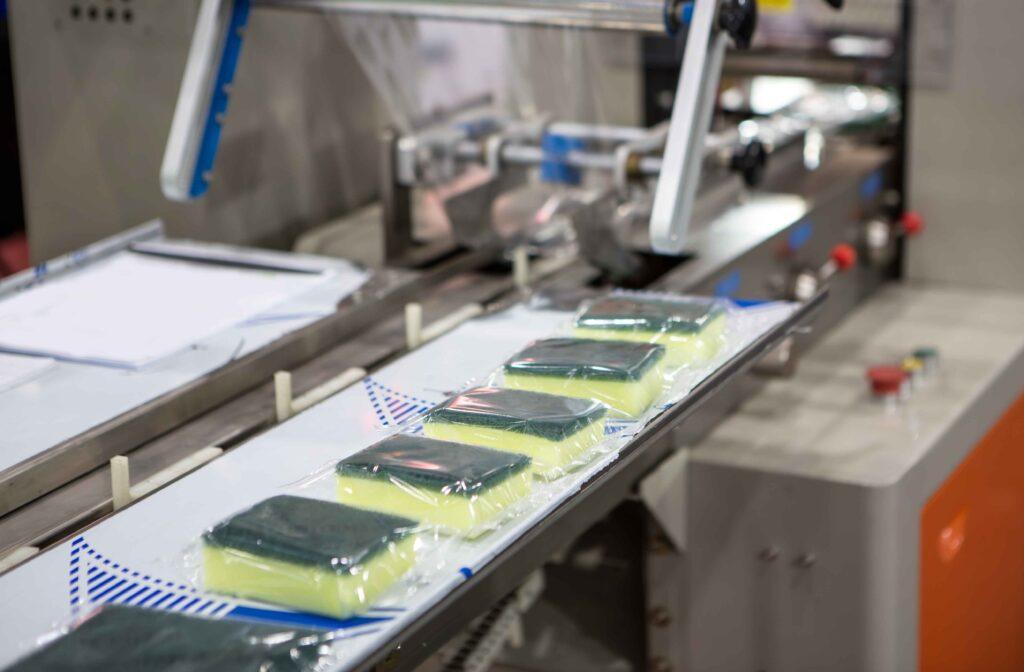The process of turning a roll of packaging film into a shelf-ready finished bag is quite complex. It involves shaping the material into the desired shape, filling it with the product to be packaged, and then sealing it (sometimes with gas) to ensure it stays fresh and protected. This process requires many individual steps and typically involves a significant amount of effort to complete. From cutting and folding the film to filling and sealing the bags, each step must be carefully executed to ensure the final product meets the necessary quality and safety standards.
Despite the complexity of the process, modern technology has made it easier than ever to turn raw packaging material into high-quality, shelf-ready bags that are both functional and aesthetically pleasing.
Manufacturers have come up with economical and efficient solutions. When it comes to packaging products, few pieces of equipment are as crucial as Vertical Form-Fill-Seal (VFFS) and Horizontal Form-Fill-Seal (HFFS) machines. They are used in almost every industry today for fast, economical packaging solutions. However, to work as fast as possible while maintaining a high quality, these machines must be supported by the proper film.
How do HFFS and VFFS machines work?
At its most basic level, form, fill, and seal machines take a large roll of film, shape it into a bag, fill the product, and seal it in one smooth, efficient process (reaching up to hundreds of bags per minute).
The process differs somewhat between the horizontal and vertical machines, as well as between specific models, but the key concepts are the same:
- The process starts with a rollstock—a large roll of film.
- The film is printed or otherwise prepared for the forming tube, where a lap seal or fin seal creates the shape of the bag. (A lap seal overlaps two outer edges of the film to create a flat seal, while a fin seal takes the insides of two outer edges to create a seal that sticks out.)
- The product fills the newly formed bag.
- From there, the bag is filled and hot-sealed. (When a seal extends through the length of a bag, it’s known as a back seal pouch.)
These machines can be automatic and accommodate many different shapes or sizes, while allowing for different product-filling tools, such as augers or volumetric cups. When printing can be added to the film it allows for the brand or product to stand out from the competition while delivering vital information to the consumer.
Learn more: Printed Stretch Film: 5 Questions You Should Ask
What qualities are packagers seeking in their form, fill, and seal bags?
Packagers are looking for versatile and economical methods of producing popular bag styles, such as pillow bags (a pillow shape with a bottom, top, and back seal).
Materials and films need to apply to most industries and applications while being:
- Fast to produce
- Cost-effective
- Simple to manufacture
One of the ways products can stand out is eye-catching packaging. Printed film is vital in creating graphics that communicate the brand’s identity while explaining the product’s capabilities.
Differences between HFFS and VFFS
The primary differences between horizontal and vertical form, fill, and seal are as follows:
VFFS:
- Perfect for sealed sachets and pouches rather than units with other closures such as zips or nozzles.
- Budget-friendly.
HFFS:
- A greater variety of packaging types and closures.
- Suitable for packing a wide range of products.
- Better for heavier products, as they travel along a conveyor belt rather than being fed from a feeding spout.
- Tends to be more expensive than VFFS.
Determining the correct material for form, fill, and seal packaging
Packagers are always looking to increase the productivity of their machines so that new machines don’t have to be purchased.
This puts pressure on makers of packaging films and resins to produce films that are of a high enough quality so that they can withstand the increase in speed. Films need to possess the correct combination of:
- Coefficient of Friction (COF): A COF is the amount of friction existing between two surfaces. The lower the value, the more sliding occurs. COF is important for form, fill, and seal machines as the film slides along belts to be shaped and sealed.
- Strength and flexibility: Film will be pulled at dramatic angles, requiring a high tensile strength and flexibility to prevent breaks.
- Secure sealing: To remain airtight during transit, the proper film needs to resist being pulled apart after being closed by sealing bars.
Stretchtape can meet your form, fill, and seal needs
Packagers need materials they know will resist tearing, can withstand high velocities, and allow them to produce product bags at pace. Whether your production process relies on VFFS or HFFS processes, we have the quality material that your organization needs.
Biaxially Oriented Polypropylene (BOPP) film from Stretchtape is one such material. Being a variation of polypropylene, BOPP film has uses in creating stickers, labels, and is also used in form, fill, and seal applications. Thanks to the material’s properties, BOPP film is:
- Puncture resistant
- Lightweight
- Temperature fluctuation resistant
- Sealable
Stretchtape can provide completely clear, matte, or white BOPP films or even deliver custom printing that ensures products stand out. The film is also moisture-resistant, allowing it to be used as packaging for beverages, medical products, and more (making it especially useful for pharmaceutical and retail packaging).
Learn more about how Stretchtape can meet your form, fill, and seal needs by contacting an expert or calling us at 216-486-9400.

